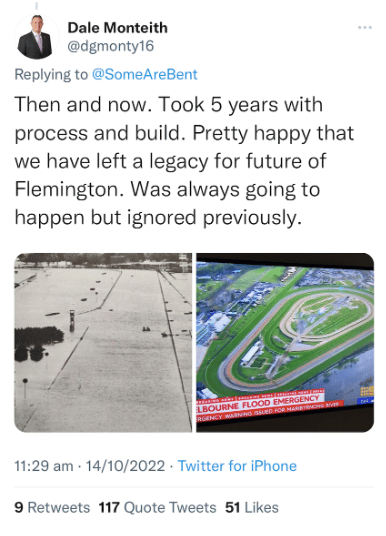The Melbourne Cup is set to begin tomorrow, but this year’s races have been tainted by severe flooding in the city. Flemington Racecourse has remained largely untouched due to its flood wall, which locals criticised for exacerbating the flooding around Maribyrnong River.
Over the past two weeks, Victorians have been hit with yet another round of flooding along many of the state’s major waterways. Regions around the Yarra, Werribee and Maribyrnong Rivers all issued major flood alerts, as Australia struggles with our third La Niña year.
In the Mairbyrnong area however, the Flemington Racecourse aggravated tension thanks to its flood wall. Many residents assert the Racecourse’s rock wall pushed excess water back onto nearby streets, while Flemington itself remained undamaged.
The suburbs around Flemington Racecourse sit on the Maribyrnong floodplain. In the past, says resident and local historian Liz Crash, when the Mari River broke its banks “you got a very shallow flood for miles around.”
This time, when the river flooded two weeks ago, the western side of the river ‘soaked up’ the water; as a floodplain should. But on the other side, says Crash, “flooding in the area around the Princes Highway, right next to the wall, that was completely flooded and a big chunk of that would have been soaked up by the floodplain.”
“The racecourse is on a flood plain and should hold floodwater when needed,” agreed State Greens MP Ellen Sandell. “Instead, this afternoon [14th October] it’s the only dry land for miles around, while people have lost their cars and are evacuating their homes in rubber dinghies.”
Victoria’s state government (then Labour) approved the construction of the flood wall back in 2004, to protect the racecourse from flooding. This was despite objections from residents, and the three councils that abut Flemington – Melbourne City, Maribyrnong and Moonee Valley.
In 2006, a year before the wall was built, Maribyrnong MP Bill Shorten penned a letter to the state water minister at the time, calling for an “urgent independent assessment” of the modelling supporting the wall’s construction. The state planning minister Rob Hulls rejected Shorten’s request, saying he was satisfied with the assessment.
Now, Melbourne Water will conduct an assessment – this time of whether the flood wall contributed to the severe flooding in the area.
Chief exec at Racing Victoria, Andrew Jones, told Channel Nine he agreed the wall had exacerbated flooding for residents. “Obviously there is no intention of the VRC to cause harm,” he asserted, “they are trying to protect the Spring Racing Carnival and the Melbourne Cup Carnival which is a massively important part of Victorian life and the Victorian economy.”
VRC chief executive Dale Monteith faced backlash after he tweeted about the success of the flood wall, which he was proud had ensured the “legacy” of racing events. Monteith said that while he did “feel for the people who have been affected”, he thought “blaming the flood wall, for all my knowledge, is not correct. He has since deleted the tweet.

Now, while racegoers are donning their slacks and fancy hats, surrounding residents and volunteers are cleaning debris from the streets and scraping mud from their houses. It’s a depressingly dystopian vision of the reality many victims of climate catastrophes face worldwide.
“Once these floodwaters subside,” Ms Sandell said, “Racing Victoria and every associated gambling entity about to bank millions at the Spring Racing Carnival better be ready to stump up the cash to help with the flood clean-up effort.”
Follow Maddie’s journalism on Twitter.
Sign Up To Our Free Newsletter